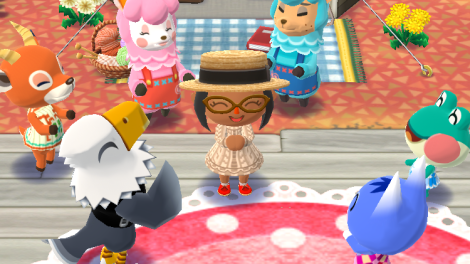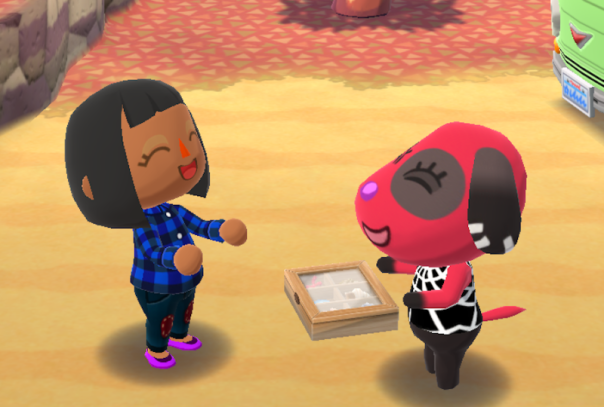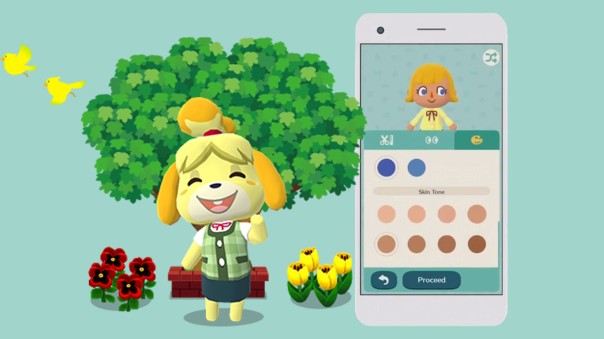Category Archives: Nintendo
Feature – Animal Crossing Pocket Camp: 5 Features I Love, 5 Features I Want

Animal Crossing fans have been paying Tom Nook their hard-earned Bells in exchange for suitable living quarters for more than a decade. Since the franchise’s initial Japanese release in 2001, Animal Crossing has blossomed into life on various Nintendo platforms over the years, including the highly commended titles Wild World (2005) and New Leaf (2012) on the Nintendo DS and 3DS respectively. While the series has gone from strength to strength on Nintendo’s handheld platforms, its venture onto home consoles has undoubtedly seen some dark days, with arguably the worst falling under Amiibo Festival (2015) on the Wii U.
The beloved franchise, which was perhaps seen as a niche title when Wild World released for the DS, turned mainstream with New Leaf’s arrival and, due to popular appeal, has seen inclusion in other Nintendo games, such as Super Smash Bros and Mario Kart 8. But this series can’t stray far from its roots and when Nintendo began to develop games for mobile devices, the Animal Crossing series was sure to be a great fit. Animal Crossing: Pocket Camp arrived for iOS and Android devices last November and accrued 15 million downloads within its first week of release. While it may have only been half of the 32 million downloads Super Mario Run obtained in the same time frame, it’s still a tremendous feat.
If you’ve been playing Pocket Camp since its release, you’ll know there’s been a fair few updates in that time. Of course, one of the largest updates added Gardens into the mobile app, but what others would you like to see? Here’s a list of five features I love and five that I would like added.
Features I love…
- Camp Amenities
Similar to Public Works Projects (PWP for short), Camp Amenities are splendid ways for your villagers to interact with at your camp site. They usually take a good 12 hours for Cyrus to build but the payoff is excellent. Animals staying at your camp site all fall under one of several themes; be it natural, cool, sporty or cute, camp amenities allow your friendship levels to grow so you can get added bonuses like t-shirts, sparkle stones and Bells. The only drawback here is that you need one heck of a lot of materials to build them, with cotton in particular the bane of many an AC Pocket Camp fan. Pro Tip: Do requests for animals that give you cotton or link up your MyNintendo account and use your in-game points for more resources.
- Rotating Animals
One of the drawbacks in the AC series is the amount of time it takes it kick a villager out of your town that you loathe. That’s right, don’t think you’re the only one – we’ve all done it. But in Pocket Camp, villagers rotate every three hours and appear in different places on your map. Plus, if you’d rather swap out a villager with another, it’s incredibly easy to say goodbye without tearing up as you can always invite them back with a calling card. - Request Interactions
Possibly the easiest way to earn friendship perks, Bells and other materials is by doing villager requests. But during these exchanges, albeit on rare occasions, you’ll receive a ‘meet-cute’ interaction. From making adorable seashell necklaces to baking a fruit pie, I just can’t get enough of these peppy on-screen actions.
- Event Themes
Like any other AC series, Pocket Camp players will receive in-game themed events during certain time periods throughout the year. From the festive theme to the New Year’s countdown theme, there’s plenty of stretch goals to achieve during these events that you’ll never stop trying to craft all the furniture in a set. Who knew AC could be so similar to Pokemon? Gotta craft ’em all. - Furniture Placement
Furniture placement has evolved since the days of City Folk (aka Let’s Go to the City in Europe) and New Leaf. In Happy Home Designer, feng shui was a real art to master, but thankfully it came with a great drag and drop tool for the closet interior designer. Pocket Camp utilises this feature wonderfully, even allowing you to put away furniture in the blink of an eye and save your layouts easily. That means no more dragging the couch from one end to the other or popping it into your Mary Poppins-esque handbag to put it at the other side of the room either.
Features I’d like…
- App Save & Close Feature
Gone are the days when Resetti used to shout verbal abuse at you from his mole hole. Now, we’ve got bigger problems and I’m pretty sure Resetti wouldn’t like it. During its early release, I’d been wondering how to shut down the app efficiently and without losing any save data. I would pay my loan to OK Motors and exit the app, but on booting the app back up the same amount was still left to be paid. Due to the game’s autosave feature activating only when travelling from area to area, some data would always be lost. Let’s have a save and close function for us forgetful folk, eh?
- Bigger Camps
Nintendo: Hey, guess what? You get to craft all this exciting new stuff but you’ll never be able to fit any of it in your camp!
Player 1: Wait, what? But there’s that little piece of land on the bottom screen that never gets used. Can we put stuff there?
Nintendo: Oh, that section? No, you can’t put camp amenities there or extend your camp. It’s for another… purpose.
Player 1: Another purpose? Oh, I get it. It’s because you’ll eventually make us pay leaf tickets to expand our camp into that section.
Nintendo: *inaudible discussion* Yes, that’s right! *internal whispering* Make sure you add that on the next update.
Player 1: Ugh… - New Areas
Between a leisurely stroll down at the beach to a spot of insect catching on a remote island, fans are chomping at the bit for new areas to explore. A beautiful city spot wouldn’t go amiss featuring K.K Slider’s newest grooves or a mini-game island to grind low-stock materials. Who knows what Nintendo will feature in the months to come.
- Swaps & Sales Market Boxes
Pocket Camp’s Market Box isn’t the most appealing feature within the mobile app, but there’s a few ways it could be improved. At the moment, players can only place materials found on the island within their boxes but wouldn’t it be super handy if fans could swap furniture or even resources instead? - Cameos
There’s already a number of rumoured key character cameos out there in the wild, but I’d love to see Kapp’n back on the seas. With his hardy-ha-ha tunes about his life on the sea and his beautiful wife, the journey to an island isn’t the same without him. It’s hard not to love someone who sings you ditties all day and night long.
So, there you have it; my top five features of what I love and want is complete. However, there’s plenty of other fun things in the AC series that could make a return in Pocket Camp. Let me know which new features you’d like in the comment section below.
Looking Beyond the Princess and the Dress: Princess Peach, Daisy and Zelda
 Looking Beyond the Princess and the Dress: Princess Peach, Daisy and Zelda
Looking Beyond the Princess and the Dress: Princess Peach, Daisy and Zelda
For many years, becoming a princess was the cherry on the cake for little girls across the world, but when those girls grew up, they lost the need to place that gold, sparkling tiara on their heads. I can’t say I blame them; when we’re faced with the harsh world of reality, taking the lead role as princess in Mushroom Kingdom becomes nothing more than a trip down Nostalgia Lane. It’s no wonder both girls and women shudder with glee when the sacred vow of marriage arrives on their doorstep, complete with a glittering white dress and tiara. But what is so interesting is why both those girls and women place so much importance in the dress, and why it, inevitably, becomes the crux of the matter.
The gaming industry has been a fan of the damsel-in-distress story arc for quite a number of years, and it appears to keep getting bigger, bolder and better. Nintendo’s own Mario has been working this plot for – well, quite frankly, forever – but it works, right? In fact, Nintendo broke the “princess barrier” a few years ago and gave Princess Peach a chance to star in her own game: Super Princess Peach.

The game, originally released in 2006 (2005 for Japan), went on to relative success with gamers and critics alike – however, they dubbed the game as being “too easy” irrevocably making it difficult to die. The abundance of hints added to this ‘easy-vibe’, which ultimately led IGN critic Craig Harris to believe Nintendo were intentionally ‘spoon-feeding’ gamers: “Nintendo goes completely out of its way to spoon-feed the player, going so far as to nearly spell out the solution to every boss battle before the player enters the fight.” There was also the murmur of Nintendo planting ‘undercurrent sexist themes’ within the game – in one specific level, Peach has to avoid the Boos, and if one brushes past to touch her, she dies. Reading between the lines here spells out certain sexual connotations for sure, but what is so frustrating is that she can’t seem to fight back. Sure, she has her chance to fight bosses, but she uses her emotions of gloom, rage, joy and calm to defeat them. Is it such a ridiculous notion to allow Princess Peach to stomp enemies flat, just like her on-off boyfriend Mario? It’s somehow ironic that she must use her umbrella to hit an enemy, as if her body is too virtuous and pure, so she must imbue her rage in an inanimate object.
 Super Princess Peach presents us with a rather interesting theory: if Peach was to take off the dress and wear women’s trousers and a shirt, accompanied by walking boots rather than dainty heels, could she shake off the damsel-in-distress image? Does her vulnerability come from her costume choice; trapped in a pink flouncy dress with nothing but white bloomers underneath? In fact, when a video game character gets the chance to shirk the dress, she does so, albeit only for half of the game in The Legend of Zelda Ocarina of Time and subsequently, The Wind Waker. In both of these examples, Princess Zelda takes on a ‘boy-ish’ image, wearing cut-off trousers and, in Ocarina of Time, even wears a scarf to cover her feminine features. But as soon as she transforms back into the princess and into the dress, she is captured by Ganondorf, ending her plight to take on the evil usurper, giving control back to the male hero. Is it too much to ask Nintendo to make a game that actually modernises the female princess, letting her control her own fate for once?
Super Princess Peach presents us with a rather interesting theory: if Peach was to take off the dress and wear women’s trousers and a shirt, accompanied by walking boots rather than dainty heels, could she shake off the damsel-in-distress image? Does her vulnerability come from her costume choice; trapped in a pink flouncy dress with nothing but white bloomers underneath? In fact, when a video game character gets the chance to shirk the dress, she does so, albeit only for half of the game in The Legend of Zelda Ocarina of Time and subsequently, The Wind Waker. In both of these examples, Princess Zelda takes on a ‘boy-ish’ image, wearing cut-off trousers and, in Ocarina of Time, even wears a scarf to cover her feminine features. But as soon as she transforms back into the princess and into the dress, she is captured by Ganondorf, ending her plight to take on the evil usurper, giving control back to the male hero. Is it too much to ask Nintendo to make a game that actually modernises the female princess, letting her control her own fate for once?

From the Mario franchise, we’ve also been tempted by the cute yellow ‘Belle’ dress that Princess Daisy wears so wonderfully. Of course, we’ve yet to see a spin-off that takes Daisy from mere Mario Kart racing to super-stomping, princess-popping heroine – hopefully though, this isn’t as far off as we first imagined. As a new generation of ‘girl-gamers’ evolves, Nintendo must supply them with role models they can look up to, and role models that don’t trap the princess in the dress.
So, why is it that the dress matters so much to both women and girls? We get to look like the stereotypical princess, if only for one day, but that’s not to say we want to wear it every day. Do you think Nintendo needs to create characters suited to modern tastes, or is it better to keep up with tradition?
